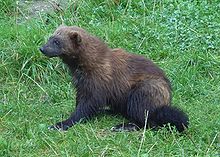| Wolverine Temporal range: Pleistocene–recent, [1]
| |
|---|---|

| |
| Scientific classification | |
| Domain: | Eukaryota |
| Kingdom: | Animalia |
| Phylum: | Chordata |
| Class: | Mammalia |
| Order: | Carnivora |
| Family: | Mustelidae |
| Genus: | Gulo |
| Species: | G. gulo
|
| Binomial name | |
| Gulo gulo | |
| Subspecies | |
|
American wolverine (G. g. luscus) | |

| |
| Wolverine ranges | |
| Synonyms | |
|
Mustela gulo Linnaeus, 1758 | |
The wolverine (/ˈwʊlvəriːn/ WUUL-və-reen, US also /ˌwʊlvəˈriːn/ WUUL-və-REEN;[4] Gulo gulo), also called the carcajou or quickhatch (from East Cree, kwiihkwahaacheew), is the largest land-dwelling member of the family Mustelidae. It is a muscular carnivore and a solitary animal.[2] The wolverine has a reputation for ferocity and strength out of proportion to its size, with the documented ability to kill prey many times larger than itself.
The wolverine is found primarily in remote reaches of the Northern boreal forests and subarctic and alpine tundra of the Northern Hemisphere, with the greatest numbers in Northern Canada, the U.S. state of Alaska, the mainland Nordic countries of Europe, and throughout western Russia and Siberia. Its population has steadily declined since the 19th century owing to trapping, range reduction and habitat fragmentation. The wolverine is now essentially absent from the southern end of its range in both Europe and North America.
- ^ "Gulo gulo Linnaeus 1758 (wolverine)-". PBDB.
- ^ a b Abramov, A.V. (2016). "Gulo gulo". IUCN Red List of Threatened Species. 2016: e.T9561A45198537. doi:10.2305/IUCN.UK.2016-1.RLTS.T9561A45198537.en. Retrieved 11 November 2021.
- ^ Andrén, H. 2018. Gulo gulo (errata version published in 2019). The IUCN Red List of Threatened Species 2018: e.T9561A144336120. Accessed on 08 February 2022 at https://www.iucnredlist.org/species/9561/144336120 Archived 23 October 2021 at the Wayback Machine.
- ^ Jones, Daniel (2011). Roach, Peter; Setter, Jane; Esling, John (eds.). Cambridge English Pronouncing Dictionary (18th ed.). Cambridge University Press. ISBN 978-0-521-15255-6.

